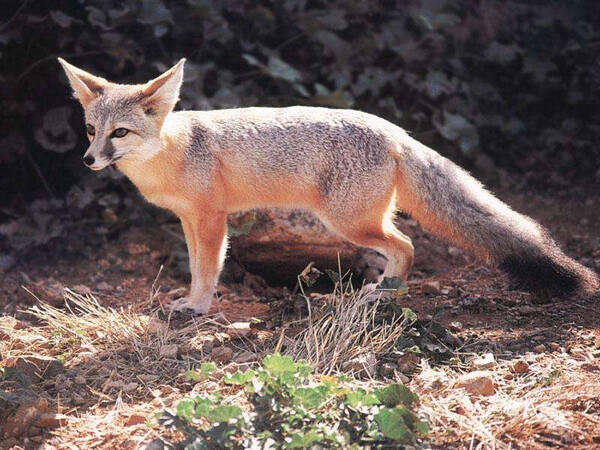Vulpes macrotis
IUCN
LCBasic Information
Scientific classification
- name:Vulpes macrotis
- Scientific Name:Vulpes macrotis,Kit Fox, Desert Fox,North American giant-eared fox, sensitive fox, North American corsac fox
- Outline:Carnivora
- Family:Schizopoda Canidae Vulpes
Vital signs
- length:38-52cm
- Weight:1.5-3kg
- lifetime:8-10years
Feature
Able to run at speeds of up to 40 km/h over short distances
Distribution and Habitat
Distributed in Mexico (Baja California, Baja California Sur, Chihuahua, Coahuila, Durango, Nuevo León, San Luis Potosi, Sonora, Zacatecas); United States (Arizona, California, Colorado, Idaho, Nevada, New Mexico, Oregon, Texas, and Utah).
It mainly inhabits arid areas such as desert scrub and grasslands. The vegetation community in the habitat area varies depending on the dryland, but some of the scrub plants in common habitats are Atriplex and Salvia. The species may also occur in agricultural areas and urban environments. Lives at an altitude of 400-1900 meters.
Appearance
The tamarin fox is one of the smallest foxes in the Americas, with a head-body length of 38-52 cm, a tail length of 22-32 cm, and a weight of 1.5-3 kg. They have a pair of conspicuous large ears with dense hair, which helps to dissipate body heat in the desert environment. This fox has a slender body, long legs, and a straight and thick tail with a black tip. The color of the fur varies with the season, ranging from rusty tan to light gray in the summer, and turning silver-gray with a white belly in the winter. The dense hair between the foot pads allows the fox to better walk on the sandy soil of its habitat, while also protecting the paws from the desert heat.
The tamarin fox and the steppe fox were once thought to be different subspecies of the same species, but scientific evidence shows that they are two different species. These two foxes are sometimes called swift foxes or agile foxes because they are able to run at speeds of 40 km/h over short distances.
Details
Kit Fox (scientific name: Vulpes macrotis), also known as Kit Fox and Desert Fox, is one of the smallest foxes in America, with no subspecies.

Kit Fox likes to build dens in places with loose soil. Spend most of their time in dens, digging their own burrows or using those of prairie dogs, other rodents, and badgers. Foxes use the same den year-round, with several dens in their range that they rotate between, which may have one or more entrances, and are usually hidden in brush and weeds.
Home range size is typically 3.22 square kilometers, in which three foxes may live. Home territories vary from 2.4-11.6 square kilometers. Have very large ears and excellent hearing. Sometimes bark at perceived threats, or use "growling" to intimidate others in inter-species encounters.
Foxes living in hot desert areas are relatively inactive, staying in their dens. Mainly nocturnal, but occasionally emerge at dusk. Stay in dens during the day and go out at night to look for food. Hunt alone. Foxes are not particularly territorial, preferring to live in underground burrows or in small family groups in pairs. Neighboring families can overlap. Females are thought to stay in the same area for relatively long periods of time, while males appear to be more dispersed.
Foxes primarily eat rodents and rabbits. Species consumed vary by region, but the most common prey are prairie dogs, kangaroos, black-tailed jackrabbits, and cottontail rabbits. Foxes are primarily carnivores, but will eat tomatoes, saguaro cactus fruit, and other edible fruits if food is scarce. They will also scavenge carrion and eat large insects, lizards, snakes, and ground-dwelling birds.
Foxes are polyandrous cooperative breeders. They are monogamous, with males and females mating in pairs for life. Polygamy has occasionally been reported. When females are ready to breed, they go out on their own to find a kennel. Breeding is usually from September to October, and male foxes stay with females until the end of the breeding season. Female subadults sometimes delay leaving the den and help raise siblings in their mother's den for more than a year after they are able to live independently. Foxes mate once a year from mid-December to February. The gestation period is 49-55 days, and can produce 1-7 pups, with an average of 4. Pups are born from February to mid-March. Although females are able to continue breeding for 10 months after the birth of their first litter, many females do not reproduce in their first year. Young females have a much lower reproductive success rate than older females.
The distribution range of the North American fox is wide, and it is not close to the critical value of vulnerable and endangered species survival (distribution area or fluctuation range is less than 20,000 square kilometers, habitat quality, population size, and distribution area fragmentation). The population trend is stable, so it is evaluated as a species with no survival crisis.
Listed in the 2014 Red List of Endangered Species of the World Conservation Union (IUCN) ver 3.1-Least Concern (LC).
Protect wild animals and eliminate game.
Maintaining ecological balance is everyone's responsibility!








